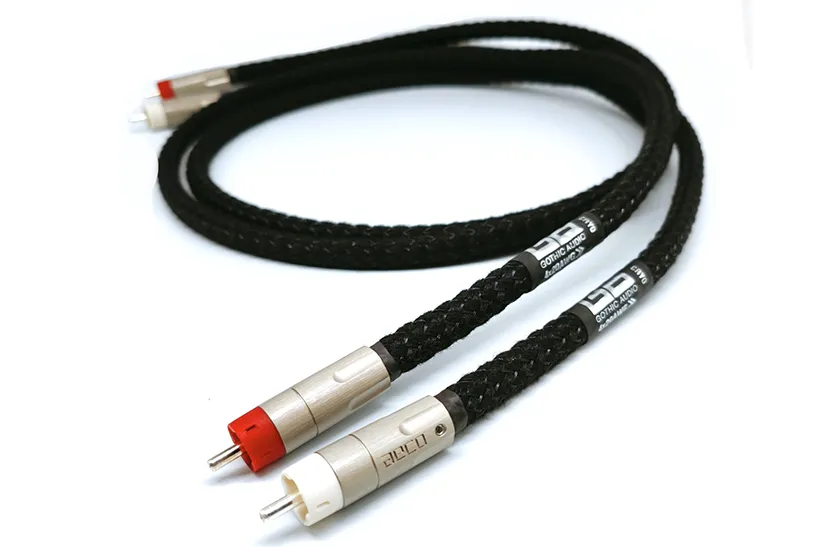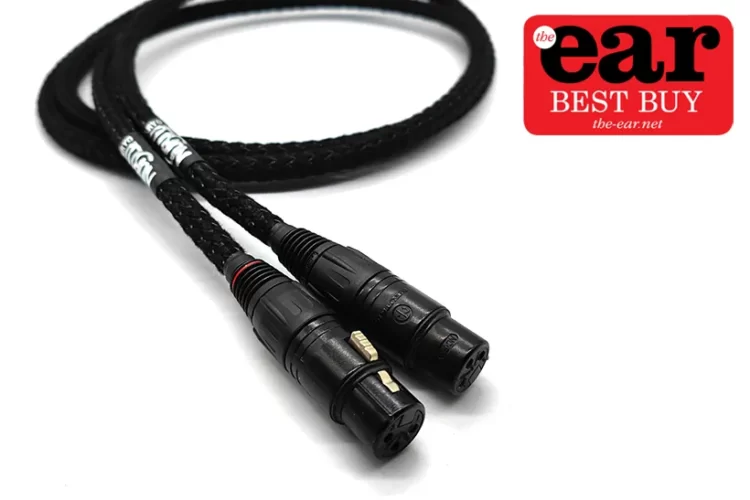Gothic Audio Nublu Cryo interconnect cable
Manchester cable-maker Chris Duwe and his Gothic Nublu cables have not featured here before on the Ear. But the company is worthy of our attention because its solid silver cables deliver remarkable value; proper sonics for not too many ££££s, especially when compared to some of the considerably pricier alternatives from major brands. Gothic Audio offers a steadily widening range. The latest to be launched is a fresh version of its best-selling Nublu interconnect.
The original Gothic Audio Nublu was built with 22 AWG 5Ns OCC silver threaded into Teflon dielectric tubing, each positive and negative run a braided pair. A cotton spacer keeps the tubing in place, and the whole assembly is encapsulated in a double shield of aluminium mylar foil and braided copper, then a silicone sheath, topped off with Techflex nylon sleeving. Duwe’s experiments with geometry and materials had resulted in Nublu having capacitance of 30pf/ft and inductance of 0.06uH/ft. On the balanced version the neutral is run through the shield, not unusual practice when cost is being controlled. Perhaps because of the quality of the drawn silver Duwe specifies, Gothic Audio Nublu required very little burn-in. It could be characterised as sounding fast, open and neutral; distinctly high-end. I bought two pairs of the XLR version for use in my reviewing system and they are used regularly to wire-up visiting audio equipment.
Duwe, it seems, is a restless soul, and he’s been further developing Gothic Audio Nublu. The new version is named Nublu Cryo, indicating that while it has similarities with the previous model, it is also different enough for us to take a fresh look. Nublu Cryo uses the same 22 AWG solid silver conductors, but rather than being hand-threaded down wide-bore Teflon tubing the wire has a coating of FEP directly applied. This more malleable form of Teflon not only gives a more constant dielectric but also excludes air to reduce oxidisation. The construction from then on is the same as the old version, but with two important changes. The first is that the Techflex outer is replaced by a woven sheath that suppresses microphony, the second is that the conductors are subjected to a three-day session of cryogenic treatment before the cable is assembled.

I was loaned two one metre pairs of the XLR version of the Nublu Cryo, with the aim of comparing it back-to-back with the old version. To do so I used the interconnects between my Mola Mola Tambaqui DAC, and a Quiescent T100SPA stereo amplifier that had taken up temporary residence. An icOn 4PRO passive line stage provided attenuation. All three components were chosen because their vanishingly low noise floors would allow more confident evaluation of new cable against old.
To establish a benchmark for my audio memory I first used two pairs of Canare star-quad balanced cables and played two tracks. I then swapped to the original Nublu and played the same two tracks before swapping to the Nublu Cryo and playing the same tracks. The volume remained untouched throughout.
10/10ths fidelity
The first track, Beethoven’s String Quartet in C minor, Op. 18 No. 4 by the Lindsays on ASV, allowed the original Gothic Audio Nublu to make the case for its solid silver conductors and construction. It sounded faster and more open than the copper Canare cable, with a more natural, less tubby sound, tonally and texturally more detailed and without the coloured mid-bass warmth that tends to accompany copper. The viola, cello and two violins had a more realistic resin bite to the transients, and the natural, balanced sweetness that characterises quality silver interconnects in a good system.
A momentary aside here. Often repeated on the web is the hoary old myth that silver sounds over-bright and bass light. It is nonsense. What can sound bass-light, and over-bright is a poorly designed silver interconnect, just as poorly-designed copper interconnect can also sound like pants. However, silver does tend to be more revealing. If we are interested in the goal of 10/10ths fidelity then that extra resolution is to be welcomed, but at the same time it can make any systemic shortcomings more apparent. Silver gets the blame, but it is simply the messenger of problems that lie elsewhere and need addressing.
Back to Gothic Audio Nublu. My second test track was A Little Rice and Beans from the 2017 release Trypnotyx by Victor Wooten, Dennis Chambers and Bob Franceschini. It is very fine example of the current state of the art in digital recording, full-bandwidth, with hugely powerful transients and a lot of subtle stuff going on in the background. The Canare cable did a competent job, but again was overshadowed by the original Nublu which made a far better job of transcribing the tonal texture and dynamic power of Wooten’s bass, and similarly the texture and transient snap of Chambers’ drums. The Canare cable conveyed the booming power with which the drum kit is played, but the Nublu revealed more detail in the power; the individual tuning of each drum, as well as how Chambers subtly modulates his wristy action to create additional texture.
The swap to the Gothic Nublu Cryo initially led me to think that nothing had changed, but on extended listening it became apparent that the amended design does offer further gains, albeit quite minimal in the grand scale of things. It might be thought that I hereby damn the new Nublu with faint praise, but not so. I am simply recognising a reality here; that there are some things cable designers should do to achieve a good result and quite a lot that they should not do. Whatever cable manufacturers claim in their marketing, there’s a loose consensus around the ‘things that should be done’; the appropriate AWG for conductors, the best dielectric materials, type of shielding, capacitance and inductance, and so on. When an interconnect is well-designed according to this consensus, as in the case of the new Gothic Nublu, differences in the sonic result between brands can become so marginal as to be of little or no consequence to perhaps the majority of buyers.
Where a real sonic break-point occurs – and it’s where in the market that the really interesting research is going on – is in the area of EMI/RFI mitigation. All competent interconnects – Gothic Nublu Cryo included – feature shielding that aims to prevent pollution present in the listening environment from getting into the cable to join and corrupt the music signal. But what shielding cannot do is have any impact on pollution already present in the conductors. The British company Networks Acoustics have developed a filter that strips out some of the RFI present in ethernet cables, while some interconnect vendors are beginning to focus on the same challenge as it affects the analogue domain.

For now, Nublu Cryo like the majority of alternative interconnects, just has shielding. And as such it is still extremely competitive; Duwe’s changes have not raised the retail price by a huge amount. I was able to compare it to a big-brand copper cable retailing at nearly £1,000 a metre and within milliseconds had concluded that if it was my money I’d buy the Gothic Nublu Cryo and maybe treat the family to a very posh supper accompanied by fine wines.
The Gothic Nublu Cryo required virtually zero running time to settle sonically, I presume due to the cryo-treatment. Straight out of the box it sounded sweet and extended with zero detectable grain or harshness, and it went on over the space of less than half an hour to stabilise and present a subjectively linear response that did not change further over the several weeks I used it.
Gothic Nublu Cryo verdict
The new version of Gothic Nublu is notably more immune to microphony than the original Nublu, undoubtedly because the conductors are encased in the dielectric rather than being able to rattle around in a wider tube, but also because of the switch to a soft, acoustically-damping outer braid. That might matter to some buyers, especially those who like to play their systems at, shall we say, enthusiastic levels. We’re getting into the realm of angels dancing on a pinhead here, but the other change apparent between old and new Nublu – and I went back and forth multiple times to be sure – is that the new version sounds more, well, more relaxed.
As Jason Kennedy noted when I complained about the sometimes difficult task of evaluating cables: ‘welcome to high-end audio’. He’s right of course, and what makes the job even more stressful in the case of the Nublu is that the old and new version are in many respects physically and electrically identical, and that the original was more than competent in the first place.
Nevertheless, Duwe has not wasted his money (or ours if we buy a pair of the new interconnects) in changing the dielectric, the outer braid, and having the conductors cryo-ed. His evolution of Gothic Nublu is thoughtful; the changes are modest but sensible and worthwhile enhancements to a high-end but low-cost interconnect. He has made a very good cable even better. If we are of normal means, and not as wealthy as Croesus, it is hard to make a convincing case for spending more.


